How to Stop Your Dog From Peeing & Pooping in the House: 11 Tips & FAQ

Updated on
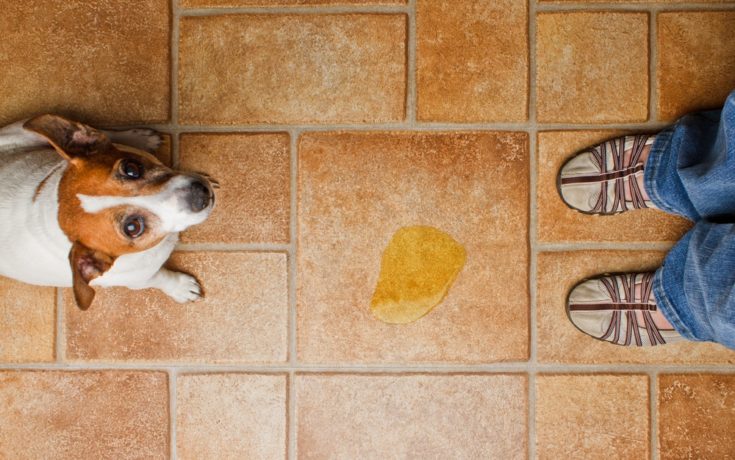
It’s a problem that many dog owners have faced at one time or another—their dog peeing or pooping in the house. For most dog owners, it’s a common occurrence when their dog is a puppy, but it can also happen when a dog gets older. Sometimes, unwanted toileting inside can be caused by illness, but it may also be the result of other causes.
With some basic steps or retraining, it is usually possible to have your dog peeing and pooping outside in a few weeks.
Why Does My Dog Pee and Poop in the House?
The most common cause of a dog peeing and pooping indoors is puppies that haven’t yet had potty training. If you have taken on a rescue dog, it may have never been trained as a puppy so even as an adult dog, it may still think it is perfectly acceptable to go inside. Illness is another potential cause, while stress or anxiety might also be causing accidents in the house, or fear might be preventing your dog from going outdoors.
The first step to stopping your dog from toileting indoors is to identify potential causes.
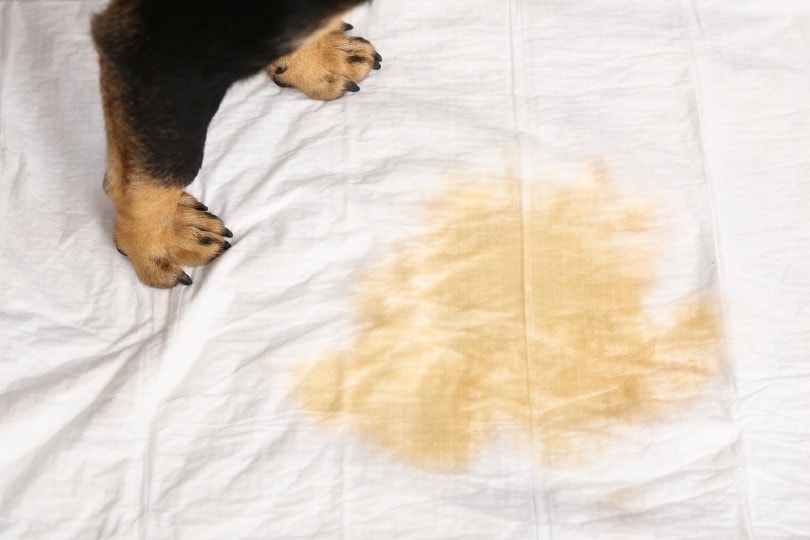
The Top 11 Ways To Stop Your Dog From Peeing & Pooping in the House
1. Look for Triggers and Deterrents
If your dog has been toilet trained but has suddenly started going indoors, rather than outdoors, there may be something preventing them from going in the garden or that is causing them to go in the house.
Check the yard or garden and make sure there is nothing that is scaring your dog. The presence of wildlife or the close proximity of neighboring dogs can be enough to prevent some pups from going outdoors. If your dog is peeing and pooping while you are out of the house or during the night, when you’re asleep, it could be a sign of separation anxiety or that something is scaring or making your dog anxious.
If you identify potential triggers, try to remove those triggers or use them to help formulate a more effective training plan.
2. Consult a Vet
You don’t need to consult a vet if your young puppy is peeing or pooping inside the house but if your adult dog has suddenly started, and you can’t find any triggers, it could be a sign of illness. In young adults, having them spayed or neutered could help remedy the problem. In older adults, it may be a mobility issue. If your dog is in pain getting up and down the back steps, for example, it may view peeing indoors as preferable to having to scale the stairs.
Your vet will check the dog and try to determine any other potential symptoms.
3. Don’t Scold Your Dog
Shouting at your dog for peeing and pooping indoors can actually make the problem worse and is very unlikely to resolve the issue. If your dog gets told off for going to the toilet, it may hide to do its business, which means that it will not only continue to pee and poop indoors but it will be much more difficult to locate. Similarly, rubbing your dog’s nose in the offending material won’t help, and it will stress your dog out.
4. Be Patient
Especially with puppies, you need to accept that toilet training takes time. It won’t happen overnight, and it can take several weeks before your little friend gets it down. And, even when they have seemingly mastered the concept, accidents can and do still happen. Be consistent with your training efforts, don’t reprimand or shout at the dog, and keep going. They will get there eventually.
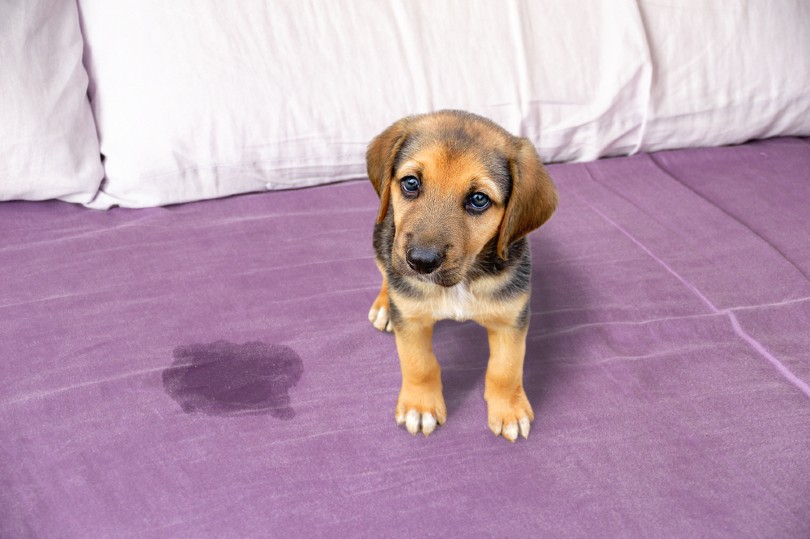
5. Use Treats
Let’s face it, most dogs are food and treat-driven. Even those that seem ignorant of your wishes and aren’t necessarily interested in making you happy will usually respond to the promise of tasty snacks. You can use this to your advantage and give your pup a treat when it successfully goes outside.
In time, the dog will learn that going outside leads to a positive response while going inside gets no response and once you are confident that they have grasped the need to toilet outside, you can gradually reduce and eventually eliminate the giving of treats.
6. Set Up a Schedule
Dogs love routine. Your dog will learn everything from the time you get up to the time your son or daughter gets home from school. They will also learn when feeding time is, and by sticking to a routine with meals, walks, and sleep, you can effectively set a toilet schedule too.
Most dogs need to go to the toilet when they wake up, about half an hour after eating, and they can get into a routine of going shortly before they go to sleep. And once your dog has this schedule, it means you can coincide these times with walks or with letting them in the garden to do their business.
7. Clean Up Fully
If your dog does pee or poop indoors, you need to clean it up quickly and thoroughly. Dogs are scent-driven and if they can smell their own wee and poo in an area, they will start to treat this as their usual toilet. Use commercial cleaners or your own homemade cleaner (typically consisting of vinegar and baking powder) to remove the stain and the scent, as well as the temptation.
Having a pet means cleaning up smells, stains, hair, vomit, and more...and you can add to your pet clean-up routine with the Hepper Advanced Bio-Enzyme Pet Stain & Odor Eliminator Spray.
- ADVANCED ENZYMATIC CLEANER - Penetrates the most stubborn smells and stains at the deepest molecular...
- FOR ANY MESS, ON ANY SURFACE - This pet odor eliminator cleans your carpets, floors, furniture,...
It's our product, and we love it so much, we just have to share! It permanently removes the very worst smells and stains, and we offer a 100% satisfaction guarantee!
8. Move Poop Outdoors
You can use this scent-driven toileting behavior to your advantage, too. Obviously, you won’t be able to lift and relocate urine, but you can pick up your dog’s poop and move it outdoors. Pick a spot where you want your dog to toilet and move the poop into that area. Encourage them to go in this area with your training, too, and you will reinforce the idea that that is the desired spot for pottying.
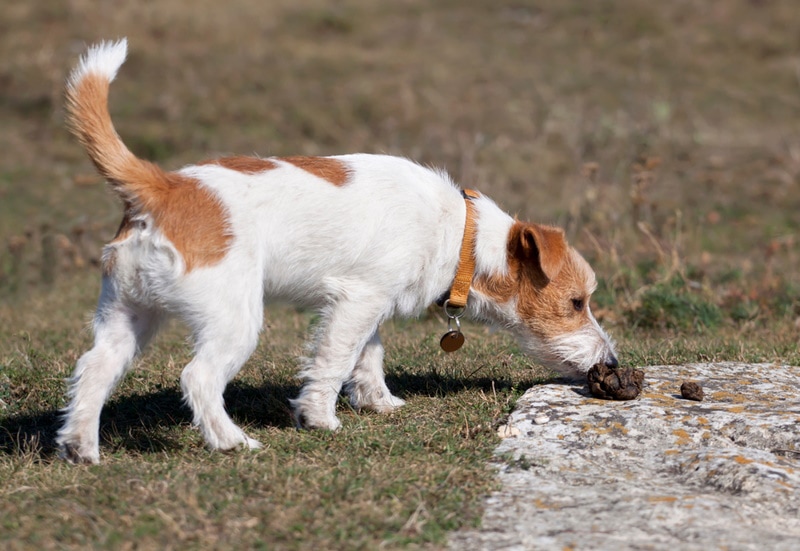
9. Interrupt Indoor Peeing and Pooping
If you see your dog preparing to pee or poop, stop them. Don’t shout but do be firm and get their attention. Most of the time, getting their attention will be enough to stop them from finishing.
10. Take Them Outdoors
If you do catch your dog about to pee or poop indoors, try picking them up and carrying them outside while putting their leash on. Take them to the area you want them to use and walk back and forth or in circles. They should get the idea and go outside. Don’t play with or lavish attention on your dog until they have been to the toilet.
11. Praise Successful Pottying
Whenever your dog pees or poops where you want them, praise them. This means verbal praise, affection, and, if you are using treats, giving a treat. While training, you shouldn’t just put the dog outside and shut the door, you will need to accompany them so you can ensure they do their business and so that you have the opportunity to praise positive behavior.
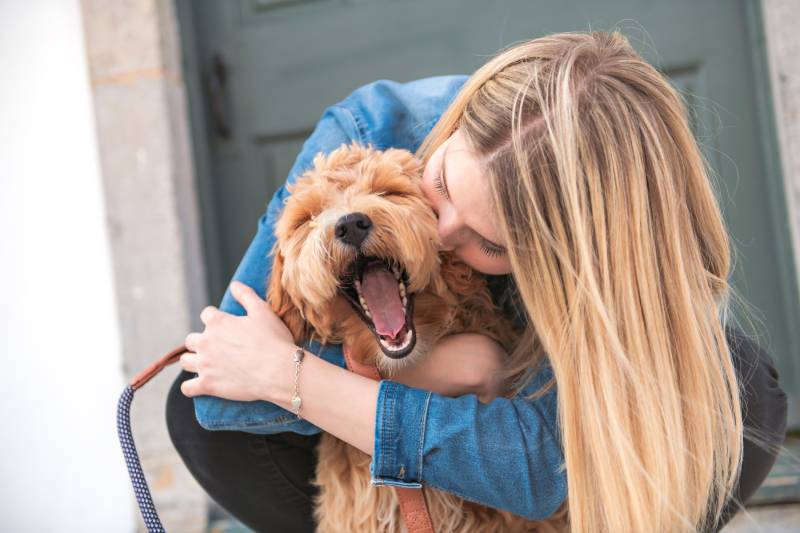
What Smells Deter Dogs from Peeing and Pooping in the House?
Although there aren’t really any smells that will stop a dog from peeing or popping directly, there are those that will mask or eliminate the smell of earlier accidents and therefore deter your dog from going again in the same spot. Vinegar is commonly used, and so too is baking soda. Citrus is also good for eliminating the smell and leaving a more pleasant aroma.
Why Does My Dog Pee in the House After Going Outside?
The main reason that puppies pee indoors after going outside is that they are comfortable and happy indoors. You need to make the outdoors a happy place, too. Spend more time outside, play with your puppy outside, although not while you’re waiting for them to toilet, and make sure you stay out with them.
Should I Take My Dog to the Veterinarian?
If your dog is a young puppy and puppy training is taking longer than you expected, it is unlikely to be a sign of illness. If yours is an adult dog that has been successfully trained but has suddenly started peeing and pooping indoors, it may be a sign of illness and you may need to take them to the vet. Look for other symptoms such as listlessness or lethargy, gastrointestinal complaints, and behavior changes.

Conclusion
A dog peeing or pooping indoors is most common in puppies that have not yet been fully toilet trained, but it can occur with adult dogs, even those that have successfully been toilet trained in the past. Be patient, don’t yell or shout at your dog, and eliminate any possible causes such as illness, anxiety, and stress.
It is possible to train adult dogs to start going outside, rather than in, but it can take time.
Featured Image Credit: MCarper, Shutterstock













